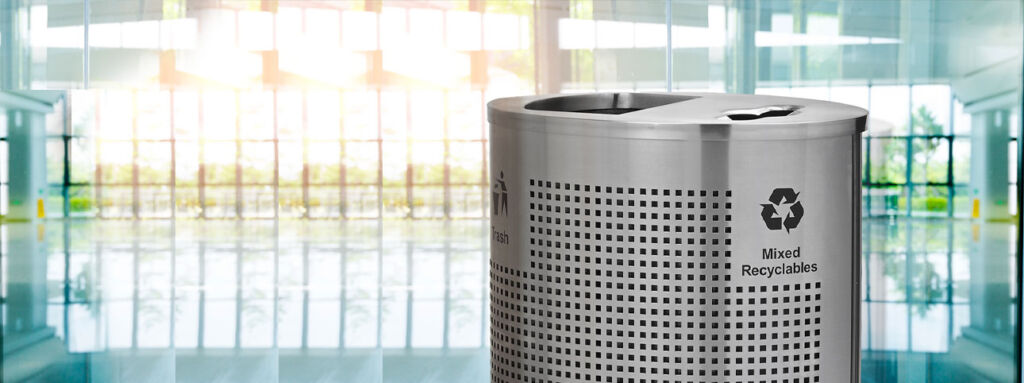December 19, 2019
Waste Reduction 101: 7 Ways to Make Your Trash Greener
Many companies are starting to address corporate sustainability and waste reduction in a big way. Why? Because it makes sense for both the environment and for business.

A recent study found that for every $1 companies invested to reduce food waste, they saved $14 in operating costs1. And paper waste is particularly costly: up to 3% of a company’s revenue is spent on paper, printing, filing and information storage2.
Making your trash greener, and saving money while doing it, is easier than you may think. Discover how with these 7 ways to get started.
1. Start with a waste audit
It’s not an activity for the faint of heart. But conducting a waste audit can be one of the best ways to figure out what types of waste are occupying the most space in your trash containers – and help you reduce them. You’ll need to identify an appropriate time, place and staff resource to sort through your trash items, categorize them and report back on the most and least common trash types.
Once you have a better idea of what’s in your trash, take a look at bin placement and volume. How full are your waste containers prior to pick-up? Which ones have the most and least trash? These insights can help you develop a baseline to measure improvements going forward. For more information on how to conduct a waste audit, check out this How to Plan a Waste Audit article from Dumpsters.com.
2. Reduce paper waste
Looking to reduce the costs associated with document storage and paper supplies? One of the easiest ways to accomplish this is to change the default settings on all your printers so they automatically print double-sided and in black-and-white (color ink is more expensive and can be difficult to recycle).
If you really want to make a meaningful impact with paper waste, consider going paperless when it comes to file storage and finances. Opt for a cloud-based solution to digitize and store data, and switch to online billing and banking. You’ll likely increase operational efficiencies as well as reducing paper waste.
3. Recycle electronic waste
Electronic waste – such as cell phones, computers, batteries, printers and cables – is increasing as technology evolves and products quickly become obsolete. If you’re not already recycling electronic waste, look for a certified provider who can handle this type of waste, which can be highly hazardous.
You can also start with a more grassroots approach. Create an upcycle station for discarded computer equipment and other office supplies or furniture, and offer it up to your employees. If someone needs a “new” item, they can check the upcycle station before placing a supplies order.
4. Eliminate single-use items
Most companies have some common single-use items that can be eliminated fairly easily – with substantial cost savings. The biggest culprit here is bottled water, which costs 2,000 times more than tap water3. Instead of providing bottled water, install a water cooler or water filters and provide glasses or re-useable bottles for employees.
You can also say goodbye to single-use cups, plates and cutlery, in addition to coffee, tea and sugar packets. Instead, invest in a set of break room dishes, glasses and utensils, and buy coffee, tea and sugar in bulk. These are simple changes that will quickly pay for themselves.
5. Evaluate your recycling program
Look at bin placement and labeling. As a rule of thumb, you should have a recycling bin next to each trash can, or have a dual waste and recycling container. And if your labels aren’t clear and consistent, you may find that more trash winds up in your recycling containers. It’s also a good idea to check in with your recycling provider to confirm what materials are – and aren’t – accepted.
If you discover that you need to upgrade your recycling containers, Commercial Zone can help. We have several durable, stylish and customizable options to suit a variety of needs. Contact us and we’ll help find the solution that’s right for you.
6. Compost food waste
If your waste audit revealed large amounts of food waste, it’s a good idea to consider composting. Food is often the heaviest – and messiest – part of the waste stream, and it’s also costly to remove. Composting services are now available in over 40 major U.S. markets3, so it’s a viable option for many companies.
In addition to rerouting food waste away from landfills, composting can also enhance soil quality and reduce erosion. Take a look at the U.S. Composting Council’s website for more information on getting started with composting.
7. Reduce packaging waste
Did you know that a third of the waste generated in developed countries is from packaging4? Cardboard is one of the most common packaging components. If you’re noticing a lot of cardboard boxes at your facility, consider storing and re-using them. Or if you’ve got too much to store, check with your waste provider about cardboard recycling – your business may even qualify for OCC rebates.
It’s also a good idea to discuss packaging options with your suppliers. Are there ways to reduce the amount or volume of packing materials? Are recycled packing materials an option? You may discover an alternative that reduces both waste and costs – a win for both parties.
Looking to enhance or evaluate your waste container options? Contact us or call 800-782-7273 to find an option that’s right for you.
1 Source: Device Magic
2 Source: World Resources Institute
3 Source: Green Biz
4 Source: EPA
